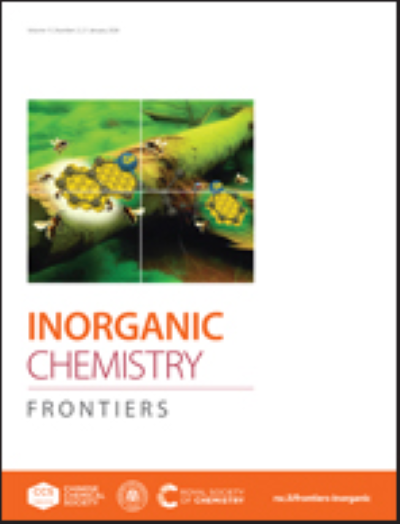Modulating Surface State of Cu Catalyst by Ga-doped Enables Tunable CO2 Electroreduction to Syngas over Wide Potential Window
IF 6.1
1区 化学
Q1 CHEMISTRY, INORGANIC & NUCLEAR
引用次数: 0
Abstract
Electrochemical CO2 reduction reaction (CO2RR) to syngas offers a powerful strategy for sustainable chemical production. Achieving syngas with tunable CO/H2 ratios within a wide potential window is highly desirable but challenging. Here, by doping Ga into Cu2(OH)2CO3 to engineer interfacial hydrophobicity and electronic structure, we effectively controlled CO and H2 production during CO2 electroreduction. We tuned the CO/H2 ratio from 0.15 to 2.1, achieving maximum 100% syngas production in a wide potential window (-0.6 to -1.8 V vs. RHE). Various characterization techniques, including in situ attenuated total reflection surface-enhanced infrared absorption spectroscopy (ATR-SEIRAS) and in situ electrochemical impedance spectroscopy (EIS), revealed that appropriate Ga doping into Cu2(OH)2CO3 facilitates CO2 mass transfer at the catalyst surface, thereby enhancing CO2RR activity. In contrast, when the Ga doping ratio reached 1.0, excessive surface hydrophobicity hinders CO2 reduction but facilitates hydrogen evolution reaction (HER). Moreover, the Ga-induced modulation of Cu+/Cu2+ ratio further exerts a synergisitic effect on C2+ product selectivity. Additionally, as the Ga doping increased, *CO binding configuration shifted from linearly bonded to bridge-bonded, revealing the reaction pathway. This versatile control of the CO/H2 ratio in CO2RR offers significant opportunities for the direct transformation of CO2 into syngas.通过ga掺杂调节Cu催化剂的表面状态,实现了宽电位窗下CO2电还原合成气的可调
电化学CO2还原反应(CO2RR)制合成气为可持续化工生产提供了一种强有力的策略。在较宽的潜力窗口内实现CO/H2比率可调的合成气是非常理想的,但具有挑战性。本研究通过在Cu2(OH)2CO3中掺杂Ga来设计界面疏水性和电子结构,有效地控制了CO2电还原过程中CO和H2的生成。我们将CO/H2比率从0.15调整到2.1,在较宽的电位窗口(-0.6至-1.8 V vs. RHE)内实现了最大的100%合成气产量。各种表征技术,包括原位衰减全反射表面增强红外吸收光谱(ATR-SEIRAS)和原位电化学阻抗谱(EIS),表明适当的Ga掺杂到Cu2(OH)2CO3中促进了CO2在催化剂表面的传质,从而增强了CO2RR活性。相比之下,当Ga掺杂比达到1.0时,过量的表面疏水性阻碍了CO2的还原,但有利于析氢反应(HER)。此外,ga诱导的Cu+/Cu2+比值的调制进一步对C2+产物选择性产生协同效应。此外,随着Ga掺杂量的增加,*CO的键构型从线性键转变为桥键,揭示了反应途径。这种对CO2RR中CO/H2比的多功能控制为将CO2直接转化为合成气提供了重要的机会。
本文章由计算机程序翻译,如有差异,请以英文原文为准。
求助全文
约1分钟内获得全文
求助全文
来源期刊

Inorganic Chemistry Frontiers
CHEMISTRY, INORGANIC & NUCLEAR-
CiteScore
10.40
自引率
7.10%
发文量
587
审稿时长
1.2 months
期刊介绍:
The international, high quality journal for interdisciplinary research between inorganic chemistry and related subjects
 求助内容:
求助内容: 应助结果提醒方式:
应助结果提醒方式:


